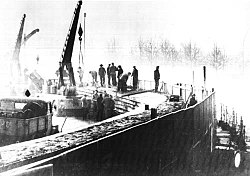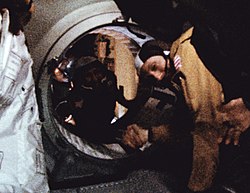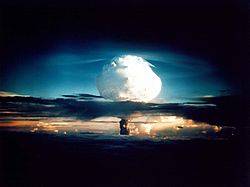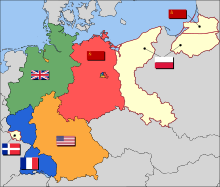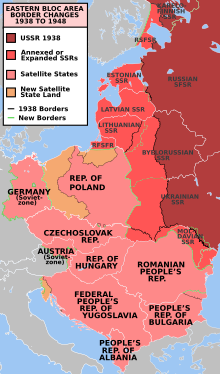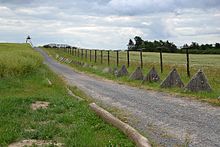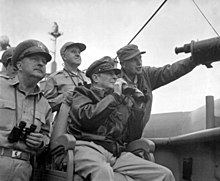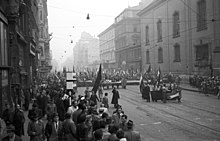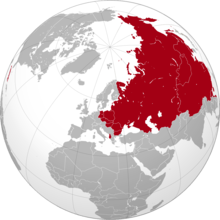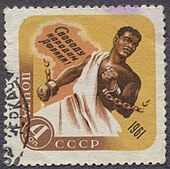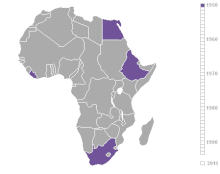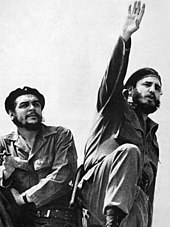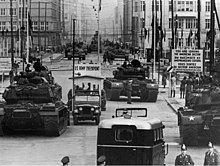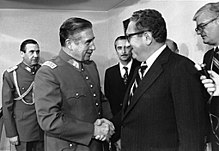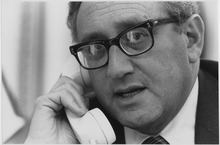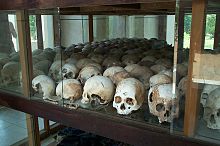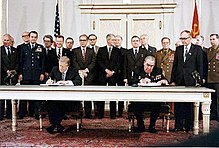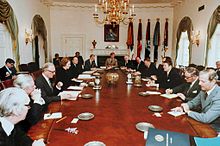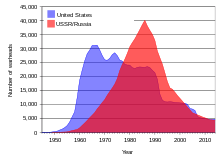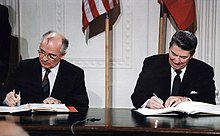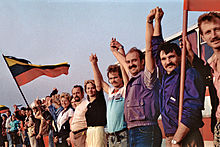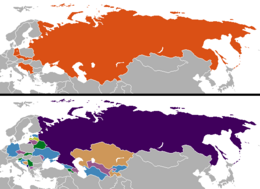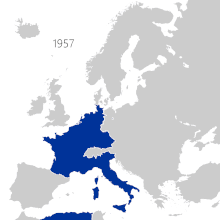The Cold War (1947–1991)
American astronaut Thomas P. Stafford and Soviet cosmonaut Alexey Leonov shake hands in outer space, 1975
Mushroom cloud of the Ivy Mike nuclear test, 1952; one of more than a thousand such tests conducted by the US between 1945 and 1992
The Cold War split the temporary wartime alliance against Nazi Germany, leaving the Soviet Union and the United States as two superpowers with profound economic and political differences. The USSR was a Marxist–Leninist state led by its Communist Party, which in turn was dominated by a leader with different titles over time, and a small committee called the Politburo. The Party controlled the state, the press, the military, the economy, and many organizations throughout the Second World, including the Warsaw Pact and other satellites, and funded communist parties around the world, sometimes in competition with communist China, particularly following the Sino-Soviet split of the 1960s. In opposition stood the capitalist West, led by the United States, a federal republic with a two-party presidential system. The First World nations of the Western Bloc were generally liberal democratic with a free press and independent organizations, but were economically and politically entwined with a network of banana republics and other authoritarian regimes throughout the Third World, most of which were the Western Bloc's former colonies. Some major Cold War frontlines such as Vietnam, Indonesia, and the Congo were still Western colonies in 1947.
A neutral bloc arose with the Non-Aligned Movement, which sought good relations with both sides. Notwithstanding relatively isolated incidents of air-to-air dogfights and shoot-downs, the two superpowers never engaged directly in full-scale armed combat. However, both were heavily armed in preparation for a possible all-out nuclear world war. Each side had a nuclear strategy that discouraged an attack by the other side, on the basis that such an attack would lead to the total destruction of the attacker—the doctrine of mutually assured destruction (MAD). Aside from the development of the two sides' nuclear arsenals, and their deployment of conventional military forces, the struggle for dominance was expressed via proxy wars around the globe, psychological warfare, massive propaganda campaigns and espionage, far-reaching embargoes, rivalry at sports events, and technological competitions such as the Space Race.
The first phase of the Cold War began in the first two years after the end of the Second World War in 1945. The USSR consolidated its control over the states of the Eastern Bloc, while the United States began a strategy of global containment to challenge Soviet power, extending military and financial aid to the countries of Western Europe (for example, supporting the anti-communist side in the Greek Civil War) and creating the NATO alliance. The Berlin Blockade (1948–49) was the first major crisis of the Cold War. With the victory of the Communist side in the Chinese Civil War and the outbreak of the Korean War (1950–53), the conflict expanded. The USSR and the US competed for influence in Latin America and the decolonizing states of Africa and Asia. The Soviets suppressed the Hungarian Revolution of 1956. The expansion and escalation sparked more crises, such as the Suez Crisis (1956), the Berlin Crisis of 1961, and the Cuban Missile Crisis of 1962, which was perhaps the closest the two sides came to nuclear war. Meanwhile, an international peace movement took root and grew among citizens around the world, first in Japan from 1954, when people became concerned about nuclear weapons testing, but soon also in Europe and the US. The peace movement, and in particular the anti-nuclear movement, gained pace and popularity from the late 1950s and early 1960s, and continued to grow through the '70s and '80s with large protest marches, demonstrations, and various non-parliamentary activism opposing war and calling for global nuclear disarmament. Following the Cuban Missile Crisis, a new phase began that saw the Sino-Soviet split complicate relations within the Communist sphere, while US allies, particularly France, demonstrated greater independence of action. The USSR crushed the 1968 Prague Spring liberalization program in Czechoslovakia, while the US experienced internal turmoil from the civil rights movement and opposition to the Vietnam War (1955–75), which ended with the defeat of the US-backed Republic of Vietnam, prompting further adjustments.
By the 1970s, both sides had become interested in making allowances in order to create a more stable and predictable international system, ushering in a period of détente that saw Strategic Arms Limitation Talks and the US opening relations with the People's Republic of China as a strategic counterweight to the Soviet Union. Détente collapsed at the end of the decade with the beginning of the Soviet–Afghan War in 1979. The early 1980s were another period of elevated tension, with the Soviet downing of KAL Flight 007 and the "Able Archer" NATO military exercises, both in 1983. The United States increased diplomatic, military, and economic pressures on the Soviet Union, at a time when the communist state was already suffering from economic stagnation. On 12 June 1982, a million protesters gathered in Central Park, New York to call for an end to the Cold War arms race and nuclear weapons in particular. In the mid-1980s, the new Soviet leader Mikhail Gorbachev introduced the liberalizing reforms of perestroika ("reorganization", 1987) and glasnost ("openness", c. 1985) and ended Soviet involvement in Afghanistan. Pressures for national independence grew stronger in Eastern Europe, especially Poland. Gorbachev meanwhile refused to use Soviet troops to bolster the faltering Warsaw Pact regimes as had occurred in the past. The result in 1989 was a wave of revolutions that peacefully (with the exception of the Romanian Revolution) overthrew all of the communist regimes of Central and Eastern Europe. The Communist Party of the Soviet Union itself lost control and was banned following an abortive coup attempt in August 1991. This in turn led to the formal dissolution of the USSR in December 1991 and the collapse of communist regimes in other countries such as Mongolia, Cambodia, and South Yemen. The United States remained as the world's only superpower.
The Cold War and its events have left a significant legacy. It is often referred to in popular culture, especially in media featuring themes of espionage (notably the internationally successful James Bond book and film franchise) and the threat of nuclear warfare. Meanwhile, a renewed state of tension between the Soviet Union's successor state, Russia, and the United States in the 2010s (including its Western allies) has been referred to as the Second Cold War.
Origins of the term
At the end of World War II, English writer George Orwell used cold war, as a general term, in his essay "You and the Atomic Bomb", published 19 October 1945 in the British newspaper Tribune. Contemplating a world living in the shadow of the threat of nuclear warfare, Orwell looked at James Burnham's predictions of a polarized world, writing:Looking at the world as a whole, the drift for many decades has been not towards anarchy but towards the reimposition of slavery... James Burnham's theory has been much discussed, but few people have yet considered its ideological implications—that is, the kind of world-view, the kind of beliefs, and the social structure that would probably prevail in a state which was at once unconquerable and in a permanent state of "cold war" with its neighbours.In The Observer of 10 March 1946, Orwell wrote, "after the Moscow conference last December, Russia began to make a 'cold war' on Britain and the British Empire."
The first use of the term to describe the specific post-war geopolitical confrontation between the Soviet Union and the United States came in a speech by Bernard Baruch, an influential advisor to Democratic presidents, on 16 April 1947. The speech, written by journalist Herbert Bayard Swope, proclaimed, "Let us not be deceived: we are today in the midst of a cold war." Newspaper columnist Walter Lippmann gave the term wide currency with his book The Cold War. When asked in 1947 about the source of the term, Lippmann traced it to a French term from the 1930s, la guerre froide.
Background
Russian Revolution
Allied troops in Vladivostok, August 1918, during the Allied intervention in the Russian Civil War
While most historians trace the origins of the Cold War to the period
immediately following World War II, others argue that it began with the
October Revolution in Russia in 1917 when the Bolsheviks took power. In 1919 Vladimir Lenin
stated that his new state was surrounded by a "hostile capitalist
encirclement", and he viewed diplomacy as a weapon that should be used
to keep the Soviet Union's enemies divided, beginning with the
establishment of the Communist International, which called for revolutionary upheavals abroad.
Historian Max Beloff argues that the Soviets saw "no prospect of
permanent peace", with the 1922 Soviet Constitution proclaiming:
Since the time of the formation of the soviet republics, the states of the world have divided into two camps: the camp of capitalism and the camp of socialism. There—in the camp of capitalism—national enmity and inequality, colonial slavery, and chauvinism, national oppression and pogroms, imperialist brutalities and wars. Here—in the camp of socialism—mutual confidence and peace, national freedom and equality, a dwelling together in peace and the brotherly collaboration of peoples.
According to British historian Christopher Sutton:
In what some have called the First Cold War, from Britain's intervention in the Russian Civil War in 1918 to its uneasy alliance with the Soviet Union against the Axis powers in 1941, British distrust of the revolutionary and regicidal Bolsheviks resulted in domestic, foreign, and colonial policies aimed at resisting the spread of communism. This conflict after 1945 took on new battlefields, new weapons, new players, and a greater intensity, but it was still fundamentally a conflict against Soviet imperialism (real and imagined).
The idea of long-term continuity is a minority scholarly view that has been challenged. Frank Ninkovich writes:
As for the two cold wars thesis, the chief problem is that the two periods are incommensurable. To be sure, they were joined together by enduring ideological hostility, but in the post-World War I years Bolshevism was not a geopolitical menace. After World War II, in contrast, the Soviet Union was a superpower that combined ideological antagonism with the kind of geopolitical threat posed by Germany and Japan in the Second World War. Even with more amicable relations in the 1920s, it is conceivable that post-1945 relations would have turned out much the same.
By 1933, old fears of Communist threats had faded, and the American
business community, as well as newspaper editors, were calling for
diplomatic recognition. President Franklin D. Roosevelt used presidential authority to normalize relations in November 1933. There were few complaints about the move.
However, there was no progress on the debt issue and little additional
trade. Historians Justus D. Doenecke and Mark A. Stoler note that, "Both
nations were soon disillusioned by the accord." Many American businessmen expected a bonus in terms of large-scale trade, but it never materialized.
The Soviets had promised not to engage in spying inside the United States, but did so anyhow. Roosevelt named William Bullitt
as ambassador from 1933 to 1936. Bullitt arrived in Moscow with high
hopes for Soviet–American relations, but his view of the Soviet
leadership soured on closer inspection. By the end of his tenure,
Bullitt was openly hostile to the Soviet government, and he remained an
outspoken anti-communist for the rest of his life.
Beginnings of World War II
In the late 1930s, Stalin had worked with Foreign Minister Maxim Litvinov to promote popular fronts with capitalist parties and governments to oppose fascism. The Soviets were embittered when Western governments chose to practice appeasement
with Nazi Germany instead. In March 1939 Britain and France—without
consulting the USSR—granted Hitler control of much of Czechoslovakia at
the Munich Agreement. Facing an aggressive Japan at Russia’s borders as well, Stalin changed directions and replaced Litvinov with Vyacheslav Molotov, who negotiated closer relations with Germany.
After signing the Molotov–Ribbentrop Pact and German–Soviet Frontier Treaty, the Soviet Union forced the Baltic countries—Estonia, Latvia, and Lithuania—to allow it to station Soviet troops in their countries under pacts of "mutual assistance". Finland rejected territorial demands, prompting a Soviet invasion in November 1939. The resulting Winter War ended in March 1940 with Finnish concessions.
Britain and France, treating the Soviet attack on Finland as tantamount
to its entering the war on the side of the Germans, responded to the
Soviet invasion by supporting the USSR's expulsion from the League of Nations.
In June 1940, the Soviet Union forcibly annexed Estonia, Latvia, and Lithuania, and the disputed Romanian regions of Bessarabia, Northern Bukovina, and Hertza. But after the German Army invaded the Soviet Union in June 1941 and the Japanese bombed Pearl Harbor
in December 1941, the Soviet Union and the Allied powers formed an
alliance of convenience. Britain signed a formal alliance and the United
States made an informal agreement. In wartime, the United States
supplied Britain, the Soviet Union and other Allied nations through its Lend-Lease Program.
However, Stalin remained highly suspicious, and he believed that the
British and the Americans had conspired to ensure that the Soviets bore
the brunt of the fighting against Germany. According to this view, the
Western Allies had deliberately delayed opening a second anti-German
front in order to step in at the last minute and shape the peace
settlement. Thus, Soviet perceptions of the West left a strong
undercurrent of tension and hostility between the Allied powers.
End of World War II (1945–1947)
Wartime conferences regarding post-war Europe
The Allies disagreed about how the European map should look, and how borders would be drawn, following the war. Each side held dissimilar ideas regarding the establishment and maintenance of post-war security.
Some scholars contend that all the Western Allies desired a security
system in which democratic governments were established as widely as
possible, permitting countries to peacefully resolve differences through
international organizations.
Others note that the Atlantic powers were divided in their vision of
the new post-war world. Roosevelt's goals—military victory in both
Europe and Asia, the achievement of global American economic supremacy
over the British Empire,
and the creation of a world peace organization—were more global than
Churchill's, which were mainly centered on securing control over the Mediterranean, ensuring the survival of the British Empire, and the independence of Central and Eastern European countries as a buffer between the Soviets and the United Kingdom.
The "Big Three" at the Yalta Conference: Winston Churchill, Franklin D. Roosevelt and Joseph Stalin, 1945
The Soviet Union sought to dominate the internal affairs of countries in its border regions.
During the war, Stalin had created special training centers for
communists from different countries so that they could set up secret
police forces loyal to Moscow as soon as the Red Army took control.
Soviet agents took control of the media, especially radio; they quickly
harassed and then banned all independent civic institutions, from youth
groups to schools, churches and rival political parties.
Stalin also sought continued peace with Britain and the United States,
hoping to focus on internal reconstruction and economic growth.
In the American view, Stalin seemed a potential ally in
accomplishing their goals, whereas in the British approach Stalin
appeared as the greatest threat to the fulfillment of their agenda. With
the Soviets already occupying most of Central and Eastern Europe,
Stalin was at an advantage, and the two western leaders vied for his
favors.
The differences between Roosevelt and Churchill led to several
separate deals with the Soviets. In October 1944, Churchill traveled to
Moscow and proposed the "percentages agreement" to divide the Balkans into respective spheres of influence, including giving Stalin predominance over Romania and Bulgaria and Churchill carte blanche over Greece. At the Yalta Conference
of February 1945, Roosevelt signed a separate deal with Stalin in
regard of Asia and refused to support Churchill on the issues of Poland
and the Reparations. Roosevelt ultimately approved the percentage agreement, but there was still apparently no firm consensus on the framework for a post-war settlement in Europe.
Post-war Allied occupation zones in Germany
At the Second Quebec Conference,
a high-level military conference held in Quebec City, 12–16 September
1944, Churchill and Roosevelt reached agreement on a number of matters,
including a plan for Germany based on Henry Morgenthau Jr.'s
original proposal. The memorandum drafted by Churchill provided for
"eliminating the warmaking industries in the Ruhr and the Saar ...
looking forward to converting Germany into a country primarily agricultural and pastoral in its character." However, it no longer included a plan to partition the country into several independent states. On 10 May 1945, President Truman signed the U.S. occupation directive JCS 1067,
which was in effect for over two years, and was enthusiastically
supported by Stalin. It directed the U.S. forces of occupation to
"...take no steps looking toward the economic rehabilitation of
Germany".
Some historians have argued that the Cold War began when the US negotiated a separate peace with Nazi SS General Karl Wolff
in northern Italy. The Soviet Union was not allowed to participate and
the dispute led to heated correspondence between Franklin Roosevelt and
Stalin. General Wolff, a war criminal, appears to have been guaranteed
immunity at the Nuremberg trials by Office of Strategic Services (OSS) commander (and later CIA director) Allen Dulles when they met in March 1945. Wolff and his forces were being considered to help implement Operation Unthinkable, a secret plan to invade the Soviet Union which Winston Churchill advocated during this period.
In April 1945, President Roosevelt died and was succeeded by Harry S. Truman, who distrusted Stalin and turned for advice to an elite group of foreign policy intellectuals. Both Churchill and Truman opposed, among other things, the Soviets' decision to prop up the Lublin government, the Soviet-controlled rival to the Polish government-in-exile in London, whose relations with the Soviets had been severed.
Following the Allies' May 1945 victory, the Soviets effectively occupied Central and Eastern Europe, while strong US and Western allied forces remained in Western Europe. In Germany and Austria,
France, Britain, the Soviet Union and the United States established
zones of occupation and a loose framework for parceled four-power
control.
The 1945 Allied conference in San Francisco established the multi-national United Nations (UN) for the maintenance of world peace, but the enforcement capacity of its Security Council was effectively paralyzed by the ability of individual members to exercise veto power.
Accordingly, the UN was essentially converted into an inactive forum
for exchanging polemical rhetoric, and the Soviets regarded it almost
exclusively as a propaganda tribune.
Potsdam Conference and surrender of Japan
Clement Attlee, Harry S. Truman and Joseph Stalin at the Potsdam Conference, 1945
At the Potsdam Conference,
which started in late July after Germany's surrender, serious
differences emerged over the future development of Germany and the rest
of Central and Eastern Europe.
Moreover, the participants' mounting antipathy and bellicose language
served to confirm their suspicions about each other's hostile
intentions, and to entrench their positions. At this conference Truman informed Stalin that the United States possessed a powerful new weapon.
The US had invited Britain into its atomic bomb project but kept
it secret from the Soviet Union. Stalin was aware that the Americans
were working on the atomic bomb, and he reacted to the news calmly. One week after the end of the Potsdam Conference, the US bombed Hiroshima and Nagasaki. Shortly after the attacks, Stalin protested to US officials when Truman offered the Soviets little real influence in occupied Japan. Stalin was also outraged by the actual dropping of the bombs, calling
them a “superbarbarity” and claiming that “the balance has been
destroyed…That cannot be.” The Truman administration intended to use its
ongoing nuclear weapons program to pressure the Soviet Union in
international relations.
Beginnings of the Eastern Bloc
Post-war territorial changes in Europe and the formation of the Eastern Bloc, the so-called 'Iron Curtain'
During the opening stages of World War II, the Soviet Union laid the foundation for the Eastern Bloc by invading and then annexing several countries as Soviet Socialist Republics, by agreement with Germany in the Molotov–Ribbentrop Pact. These included eastern Poland (incorporated into the Byelorussian SSR and the Ukrainian SSR), Latvia (which became the Latvian SSR), Estonia (which became the Estonian SSR), Lithuania (which became the Lithuanian SSR), part of eastern Finland (which became the Karelo-Finnish SSR) and eastern Romania (which became the Moldavian SSR).
The Central and Eastern European territories liberated from Germany and occupied by the Soviet armed forces were added to the Eastern Bloc by converting them into satellite states, such as:
 People's Republic of Albania (11 January 1946)
People's Republic of Albania (11 January 1946) People's Republic of Bulgaria (15 September 1946)
People's Republic of Bulgaria (15 September 1946) Polish People's Republic (19 January 1947)
Polish People's Republic (19 January 1947) People's Republic of Romania (13 April 1948)
People's Republic of Romania (13 April 1948) Czechoslovak Socialist Republic (9 May 1948)
Czechoslovak Socialist Republic (9 May 1948) Hungarian People's Republic (20 August 1949)
Hungarian People's Republic (20 August 1949) German Democratic Republic (7 October 1949)
German Democratic Republic (7 October 1949)
The Soviet-style regimes that arose in the Bloc not only reproduced Soviet command economy, but also adopted the brutal methods employed by Joseph Stalin and the Soviet secret police in order to suppress both real and potential opposition. In Asia, the Red Army had overrun Manchuria in the last month of the war, and it went on to occupy the large swathe of Korean territory located north of the 38th parallel.
As part of consolidating Stalin's control over the Eastern Bloc, the People's Commissariat for Internal Affairs (NKVD), led by Lavrentiy Beria,
supervised the establishment of Soviet-style secret police systems in
the Bloc that were supposed to crush anti-communist resistance.
When the slightest stirrings of independence emerged in the Bloc,
Stalin's strategy matched that of dealing with domestic pre-war rivals:
they were removed from power, put on trial, imprisoned, and in several
instances, executed.
British Prime Minister Winston Churchill
was concerned that, given the enormous size of Soviet forces deployed
in Europe at the end of the war, and the perception that Soviet leader
Joseph Stalin was unreliable, there existed a Soviet threat to Western
Europe.
After World War II, US officials guided Western European leaders in
establishing their own secret security force to prevent subversion in
the Western bloc, which evolved into Operation Gladio.
Containment and the Truman Doctrine (1947–1953)
The Iron Curtain, Iran, Turkey, and Greece
Remains of the "iron curtain" in the Czech Republic
In late February 1946, George F. Kennan's "Long Telegram"
from Moscow to Washington helped to articulate the US government's
increasingly hard line against the Soviets, which would become the basis
for US strategy toward the Soviet Union for the duration of the Cold
War. The Truman Administration was receptive to the telegram due to
broken promises by Stalin concerning Europe and Iran. Following the WWII Anglo-Soviet invasion of Iran, the country was occupied by the Red Army in the far north and the British in the south.
Iran was used by the United States and British to supply the Soviet
Union, and the Allies agreed to withdraw from Iran within six months
after the cessation of hostilities. However, when this deadline came, the Soviets remained in Iran under the guise of the People's Republic of Azerbaijan and Kurdish Republic of Mahabad. Shortly thereafter, on 5 March, former British prime minister Winston Churchill delivered his famous "Iron Curtain" speech in Fulton, Missouri.
The speech called for an Anglo-American alliance against the Soviets,
whom he accused of establishing an "iron curtain" dividing Europe from "Stettin in the Baltic to Trieste in the Adriatic".
A week later, on 13 March, Stalin responded vigorously to the speech, saying that Churchill could be compared to Hitler insofar as he advocated the racial superiority of English-speaking nations
so that they could satisfy their hunger for world domination, and that
such a declaration was "a call for war on the U.S.S.R." The Soviet
leader also dismissed the accusation that the USSR was exerting
increasing control over the countries lying in its sphere. He argued
that there was nothing surprising in "the fact that the Soviet Union,
anxious for its future safety, [was] trying to see to it that
governments loyal in their attitude to the Soviet Union should exist in
these countries".
In September, the Soviet side produced the Novikov telegram, sent by the Soviet ambassador to the US but commissioned and "co-authored" by Vyacheslav Molotov;
it portrayed the US as being in the grip of monopoly capitalists who
were building up military capability "to prepare the conditions for
winning world supremacy in a new war". On 6 September 1946, James F. Byrnes delivered a speech in Germany repudiating the Morgenthau Plan
(a proposal to partition and de-industrialize post-war Germany) and
warning the Soviets that the US intended to maintain a military presence
in Europe indefinitely.
As Byrnes admitted a month later, "The nub of our program was to win
the German people ... it was a battle between us and Russia over
minds ..." In December, the Soviets agreed to withdraw from Iran after persistent US pressure, an early success of containment policy.
By 1947, US president Harry S. Truman
was outraged by perceived resistance of the Soviet Union to American
demands in Iran, Turkey, and Greece, as well as Soviet rejection of the Baruch Plan on nuclear weapons. In February 1947, the British government announced that it could no longer afford to finance the Kingdom of Greece in its civil war against Communist-led insurgents. The US government responded to this announcement by adopting a policy of containment,
with the goal of stopping the spread of Communism. Truman delivered a
speech calling for the allocation of $400 million to intervene in the
war and unveiled the Truman Doctrine, which framed the conflict as a contest between free peoples and totalitarian regimes. American policymakers accused the Soviet Union of conspiring against the Greek royalists in an effort to expand Soviet influence even though Stalin had told the Communist Party to cooperate with the British-backed government. (The insurgents were helped by Josip Broz Tito's Socialist Federal Republic of Yugoslavia against Stalin's wishes.)
Enunciation of the Truman Doctrine marked the beginning of a US bipartisan defense and foreign policy consensus between Republicans and Democrats focused on containment and deterrence that weakened during and after the Vietnam War, but ultimately persisted thereafter.
Moderate and conservative parties in Europe, as well as social
democrats, gave virtually unconditional support to the Western alliance, while European and American Communists, financed by the KGB and involved in its intelligence operations, adhered to Moscow's line, although dissent began to appear after 1956. Other critiques of the consensus policy came from anti-Vietnam War activists, the Campaign for Nuclear Disarmament, and the anti-nuclear movement.
Marshall Plan and Czechoslovak coup d'état
Map of Cold War-era Europe and the Near East showing countries that received Marshall Plan aid. The red columns show the relative amount of total aid received per nation.
In early 1947, France, Britain and the United States unsuccessfully
attempted to reach an agreement with the Soviet Union for a plan
envisioning an economically self-sufficient Germany, including a
detailed accounting of the industrial plants, goods and infrastructure
already removed by the Soviets. In June 1947, in accordance with the Truman Doctrine, the United States enacted the Marshall Plan, a pledge of economic assistance for all European countries willing to participate, including the Soviet Union.
Under the plan, which President Harry S. Truman signed on 3 April 1948,
the US government gave to Western European countries over $13 billion
(equivalent to $189.39 billion in 2016) to rebuild the economy of Europe. Later, the program led to the creation of the Organisation for European Economic Co-operation.
The plan's aim was to rebuild the democratic and economic systems of Europe and to counter perceived threats to Europe's balance of power, such as communist parties seizing control through revolutions or elections. The plan also stated that European prosperity was contingent upon German economic recovery. One month later, Truman signed the National Security Act of 1947, creating a unified Department of Defense, the Central Intelligence Agency (CIA), and the National Security Council (NSC). These would become the main bureaucracies for US defense policy in the Cold War.
Stalin believed that economic integration with the West would allow Eastern Bloc countries to escape Soviet control, and that the US was trying to buy a pro-US re-alignment of Europe. Stalin therefore prevented Eastern Bloc nations from receiving Marshall Plan aid.
The Soviet Union's alternative to the Marshall Plan, which was
purported to involve Soviet subsidies and trade with central and eastern
Europe, became known as the Molotov Plan (later institutionalized in January 1949 as the Council for Mutual Economic Assistance).
Stalin was also fearful of a reconstituted Germany; his vision of a
post-war Germany did not include the ability to rearm or pose any kind
of threat to the Soviet Union.
In early 1948, following reports of strengthening "reactionary elements", Soviet operatives executed a coup d'état in Czechoslovakia, the only Eastern Bloc state that the Soviets had permitted to retain democratic structures.
The public brutality of the coup shocked Western powers more than any
event up to that point, set in a motion a brief scare that war would
occur and swept away the last vestiges of opposition to the Marshall
Plan in the United States Congress.
The twin policies of the Truman Doctrine and the Marshall Plan
led to billions in economic and military aid for Western Europe, Greece,
and Turkey. With the US assistance, the Greek military won its civil war. Under the leadership of Alcide De Gasperi the Italian Christian Democrats defeated the powerful Communist–Socialist alliance in the elections of 1948.
Espionage
All major powers engaged in espionage, using a great variety of
spies, double agents, and new technologies such as the tapping of
telephone cables. The most famous and active organizations were the American CIA, the Soviet KGB, and the British MI6. The East German Stasi, unlike the others, was primarily concerned with internal security, but its Main Directorate for Reconnaissance operated espionage activities around the world. The CIA secretly subsidized and promoted anti-communist cultural activities and organizations. The CIA was also involved in European politics, especially in Italy. Espionage took place all over the world, but Berlin was the most important battleground for spying activity.
So much top secret archival information has been released so that historian Raymond L. Garthoff
concludes there probably was parity in the quantity and quality of
secret information obtained by each side. However, the Soviets probably
had an advantage in terms of HUMINT (espionage) and "sometimes in its
reach into high policy circles." In terms of decisive impact, however,
he concludes:
- We also can now have high confidence in the judgment that there were no successful “moles” at the political decision-making level on either side. Similarly, there is no evidence, on either side, of any major political or military decision that was prematurely discovered through espionage and thwarted by the other side. There also is no evidence of any major political or military decision that was crucially influenced (much less generated) by an agent of the other side.
In addition to usual espionage, the Western agencies paid special attention to debriefing Eastern Bloc defectors.
Cominform and the Tito–Stalin Split
In September 1947, the Soviets created Cominform,
the purpose of which was to enforce orthodoxy within the international
communist movement and tighten political control over Soviet satellites through coordination of communist parties in the Eastern Bloc. Cominform faced an embarrassing setback the following June, when the Tito–Stalin Split obliged its members to expel Yugoslavia, which remained communist but adopted a non-aligned position.
Berlin Blockade and Airlift
C-47s unloading at Tempelhof Airport in Berlin during the Berlin Blockade
The United States and Britain merged their western German occupation zones into "Bizonia" (1 January 1947, later "Trizonia" with the addition of France's zone, April 1949).
As part of the economic rebuilding of Germany, in early 1948,
representatives of a number of Western European governments and the
United States announced an agreement for a merger of western German
areas into a federal governmental system. In addition, in accordance with the Marshall Plan, they began to re-industrialize and rebuild the German economy, including the introduction of a new Deutsche Mark currency to replace the old Reichsmark currency that the Soviets had debased.
Shortly thereafter, Stalin instituted the Berlin Blockade
(24 June 1948 – 12 May 1949), one of the first major crises of the Cold
War, preventing food, materials and supplies from arriving in West Berlin.
The United States, Britain, France, Canada, Australia, New Zealand and
several other countries began the massive "Berlin airlift", supplying
West Berlin with food and other provisions.
The Soviets mounted a public relations campaign against the
policy change. Once again the East Berlin communists attempted to
disrupt the Berlin municipal elections (as they had done in the 1946 elections), which were held on 5 December 1948 and produced a turnout of 86.3% and an overwhelming victory for the non-communist parties.
The results effectively divided the city into East and West versions of
its former self. 300,000 Berliners demonstrated and urged the
international airlift to continue, and US Air Force pilot Gail Halvorsen created "Operation Vittles", which supplied candy to German children. In May 1949, Stalin backed down and lifted the blockade.
In 1952, Stalin repeatedly proposed a plan
to unify East and West Germany under a single government chosen in
elections supervised by the United Nations, if the new Germany were to
stay out of Western military alliances, but this proposal was turned
down by the Western powers. Some sources dispute the sincerity of the
proposal.
Beginnings of NATO and Radio Free Europe
President Truman signs the North Atlantic Treaty with guests in the Oval Office.
Britain, France, the United States, Canada and other eight western European countries signed the North Atlantic Treaty of April 1949, establishing the North Atlantic Treaty Organization (NATO). That August, the first Soviet atomic device was detonated in Semipalatinsk, Kazakh SSR. Following Soviet refusals to participate in a German rebuilding effort set forth by western European countries in 1948, the US, Britain and France spearheaded the establishment of West Germany from the three Western zones of occupation in April 1949. The Soviet Union proclaimed its zone of occupation in Germany the German Democratic Republic that October.
Media in the Eastern Bloc was an organ of the state,
completely reliant on and subservient to the communist party. Radio and
television organizations were state-owned, while print media was
usually owned by political organizations, mostly by the local communist
party.
Soviet propaganda used Marxist philosophy to attack capitalism,
claiming labor exploitation and war-mongering imperialism were inherent
in the system.
Along with the broadcasts of the British Broadcasting Corporation (BBC) and the Voice of America to Central and Eastern Europe, a major propaganda effort begun in 1949 was Radio Free Europe/Radio Liberty, dedicated to bringing about the peaceful demise of the communist system in the Eastern Bloc.
Radio Free Europe attempted to achieve these goals by serving as a
surrogate home radio station, an alternative to the controlled and
party-dominated domestic press.
Radio Free Europe was a product of some of the most prominent
architects of America's early Cold War strategy, especially those who
believed that the Cold War would eventually be fought by political
rather than military means, such as George F. Kennan.
American policymakers, including Kennan and John Foster Dulles, acknowledged that the Cold War was in its essence a war of ideas.
The United States, acting through the CIA, funded a long list of
projects to counter the communist appeal among intellectuals in Europe
and the developing world. The CIA also covertly sponsored a domestic propaganda campaign called Crusade for Freedom.
In the early 1950s, the US worked for the rearmament of West Germany and, in 1955, secured its full membership of NATO.
In May 1953, Beria, by then in a government post, had made an
unsuccessful proposal to allow the reunification of a neutral Germany to
prevent West Germany's incorporation into NATO.
Chinese Civil War and SEATO
Mao Zedong and Joseph Stalin in Moscow, December 1949
In 1949, Mao Zedong's People's Liberation Army defeated Chiang Kai-shek's United States-backed Kuomintang
(KMT) Nationalist Government in China, and the Soviet Union promptly
created an alliance with the newly formed People's Republic of China. According to Norwegian historian Odd Arne Westad,
the communists won the Civil War because they made fewer military
mistakes than Chiang Kai-Shek made, and because in his search for a
powerful centralized government, Chiang antagonized too many interest
groups in China. Moreover, his party was weakened during the war against Japan.
Meanwhile, the communists told different groups, such as the peasants,
exactly what they wanted to hear, and they cloaked themselves under the
cover of Chinese nationalism.
Chiang and his KMT government retreated to the island of Taiwan. Confronted with the communist revolution in China and the end of the American atomic monopoly in 1949, the Truman administration quickly moved to escalate and expand its containment policy. In NSC 68, a secret 1950 document, the National Security Council proposed to reinforce pro-Western alliance systems and quadruple spending on defense.
United States officials moved thereafter to expand containment into Asia, Africa, and Latin America,
in order to counter revolutionary nationalist movements, often led by
communist parties financed by the USSR, fighting against the restoration
of Europe's colonial empires in South-East Asia and elsewhere. In the early 1950s (a period sometimes known as the "Pactomania"), the US formalized a series of alliances with Japan, Australia, New Zealand, Thailand and the Philippines (notably ANZUS in 1951 and SEATO in 1954), thereby guaranteeing the United States a number of long-term military bases.
Korean War
General Douglas MacArthur, UN Command CiC (seated), observes the naval shelling of Incheon from USS Mt. McKinley, 15 September 1950
One of the more significant examples of the implementation of containment was US intervention in the Korean War. In June 1950, Kim Il-sung's North Korean People's Army invaded South Korea. Stalin approved and sent advisers to plan the North Korean invasion. To Stalin's surprise, the UN Security Council backed the defense of South Korea, though the Soviets were then boycotting meetings in protest that Taiwan and not Communist China held a permanent seat on the Council. A UN force
of personnel from South Korea, the United States, the United Kingdom,
Turkey, Canada, Colombia, Australia, France, South Africa, the
Philippines, the Netherlands, Belgium, New Zealand and other countries
joined to stop the invasion.
U.S. Marines engaged in street fighting during the liberation of Seoul, September 1950
Among other effects, the Korean War galvanized NATO to develop a military structure.
Public opinion in countries involved, such as Great Britain, was
divided for and against the war. Many feared an escalation into a
general war with Communist China, and even nuclear war. The strong
opposition to the war often strained Anglo-American relations.
For these reasons British officials sought a speedy end to the
conflict, hoping to unite Korea under United Nations auspices and for
withdrawal of all foreign forces.
Even though the Chinese and North Koreans were exhausted by the
war and were prepared to end it by late 1952, Stalin insisted that they
continue fighting, and the Armistice was approved only in July 1953, after Stalin's death. North Korean leader Kim Il Sung created a highly centralized, totalitarian dictatorship—which continues to date—according himself unlimited power and generating a formidable cult of personality. In the South, the American-backed strongman Syngman Rhee ran a significantly less brutal but deeply corrupt and authoritarian regime.
After Rhee was overthrown in 1960, South Korea fell within a year under
a period of military rule that lasted until the re-establishment of a
multi-party system in the late 1980s.
Crisis and escalation (1953–1962)
Khrushchev, Eisenhower and de-Stalinization
NATO and Warsaw Pact troop strengths in Europe in 1959
In 1953, changes in political leadership on both sides shifted the dynamic of the Cold War. Dwight D. Eisenhower
was inaugurated president that January. During the last 18 months of
the Truman administration, the American defense budget had quadrupled,
and Eisenhower moved to reduce military spending by a third while
continuing to fight the Cold War effectively.
After the death of Joseph Stalin, Nikita Khrushchev became the Soviet leader following the deposition and execution of Lavrentiy Beria and the pushing aside of rivals Georgy Malenkov and Vyacheslav Molotov. On 25 February 1956, Khrushchev shocked delegates to the 20th Congress of the Soviet Communist Party by cataloguing and denouncing Stalin's crimes. As part of a campaign of de-Stalinization, he declared that the only way to reform and move away from Stalin's policies would be to acknowledge errors made in the past.
On 18 November 1956, while addressing Western ambassadors at a
reception at the Polish embassy in Moscow, Khrushchev used his famous
"Whether you like it or not, history is on our side. We will bury you" expression, shocking everyone present.
He later claimed that he had not been talking about nuclear war, but
rather about the historically determined victory of communism over
capitalism.
In 1961, Khrushchev declared that even if the USSR was behind the West,
within a decade its housing shortage would disappear, consumer goods
would be abundant, and within two decades, the "construction of a
communist society" in the USSR would be completed "in the main".
Eisenhower's secretary of state, John Foster Dulles, initiated a "New Look" for the containment strategy, calling for a greater reliance on nuclear weapons against US enemies in wartime. Dulles also enunciated the doctrine of "massive retaliation",
threatening a severe US response to any Soviet aggression. Possessing
nuclear superiority, for example, allowed Eisenhower to face down Soviet
threats to intervene in the Middle East during the 1956 Suez Crisis.
US plans for nuclear war in the late 1950s included the "systematic
destruction" of 1,200 major urban centers in the Eastern Bloc and China,
including Moscow, East Berlin and Beijing, with their civilian
populations among the primary targets.
Warsaw Pact and Hungarian Revolution
The maximum territorial extent of countries in the world under Soviet influence, after the Cuban Revolution of 1959 and before the official Sino-Soviet split of 1961
While Stalin's death in 1953 slightly relaxed tensions, the situation in Europe remained an uneasy armed truce. The Soviets, who had already created a network of mutual assistance treaties in the Eastern Bloc by 1949, established a formal alliance therein, the Warsaw Pact, in 1955.
The Hungarian Revolution of 1956 occurred shortly after Khrushchev arranged the removal of Hungary's Stalinist leader Mátyás Rákosi. In response to a popular uprising, the new regime formally disbanded the secret police, declared its intention to withdraw from the Warsaw Pact and pledged to re-establish free elections. The Soviet Army invaded. Thousands of Hungarians were arrested, imprisoned and deported to the Soviet Union, and approximately 200,000 Hungarians fled Hungary in the chaos. Hungarian leader Imre Nagy and others were executed following secret trials.
From 1957 through 1961, Khrushchev openly and repeatedly threatened the
West with nuclear annihilation. He claimed that Soviet missile
capabilities were far superior to those of the United States, capable of
wiping out any American or European city. However, Khrushchev rejected
Stalin's belief in the inevitability of war, and declared his new goal
was to be "peaceful coexistence". This formulation modified the Stalin-era Soviet stance, where international class conflict
meant the two opposing camps were on an inevitable collision course
where communism would triumph through global war; now, peace would allow
capitalism to collapse on its own, as well as giving the Soviets time to boost their military capabilities,
which remained for decades until Gorbachev's later "new thinking"
envisioning peaceful coexistence as an end in itself rather than a form
of class struggle.
The events in Hungary produced ideological fractures within the
communist parties of the world, particularly in Western Europe, with
great decline in membership as many in both western and communist
countries felt disillusioned by the brutal Soviet response.
The communist parties in the West would never recover from the effect
the Hungarian Revolution had on their membership, a fact that was
immediately recognized by some, such as the Yugoslavian politician Milovan Đilas
who shortly after the revolution was crushed said that "The wound which
the Hungarian Revolution inflicted on communism can never be completely
healed".
America's pronouncements concentrated on American strength abroad and the success of liberal capitalism.
However, by the late 1960s, the "battle for men's minds" between two
systems of social organization that Kennedy spoke of in 1961 was largely
over, with tensions henceforth based primarily on clashing geopolitical
objectives rather than ideology.
Berlin ultimatum and European integration
During November 1958, Khrushchev made an unsuccessful attempt to turn
all of Berlin into an independent, demilitarized "free city". He gave
the United States, Great Britain, and France a six-month ultimatum to
withdraw their troops from the sectors they still occupied in West
Berlin, or he would transfer control of Western access rights to the
East Germans. Khrushchev earlier explained to Mao Zedong that "Berlin is the testicles of the West. Every time I want to make the West scream, I squeeze on Berlin."
NATO formally rejected the ultimatum in mid-December and Khrushchev
withdrew it in return for a Geneva conference on the German question.
More broadly, one hallmark of the 1950s was the beginning of European integration—a
fundamental by-product of the Cold War. Truman and Eisenhower promoted
the concept politically, economically, and militarily, but later
administrations viewed it ambivalently, fearful that an independent
Europe would forge a separate détente with the Soviet Union, which would
use this to exacerbate Western disunity.
Competition in the Third World
Western colonial empires in Asia and Africa all collapsed in the years after 1945.
Nationalist movements in some countries and regions, notably Guatemala, Indonesia and Indochina, were often allied with communist groups or perceived in the West to be allied with communists. In this context, the United States and the Soviet Union increasingly competed for influence by proxy in the Third World as decolonization gained momentum in the 1950s and early 1960s. Additionally, the Soviets saw continuing losses by imperial powers as presaging the eventual victory of their ideology. Both sides were selling armaments to gain influence.
1961 Soviet postage stamp demanding freedom for African nations
1961 Soviet stamp commemorating Patrice Lumumba, prime minister of the Republic of the Congo
The United States used the Central Intelligence Agency (CIA) to do away with a string of unfriendly Third World governments and to support allied ones. In 1953, President Eisenhower's CIA implemented Operation Ajax, a covert operation aimed at overthrowing the Iranian prime minister, Mohammad Mosaddegh.
The popularly elected and non-aligned Mosaddegh had been a Middle
Eastern nemesis of Britain since nationalizing the British-owned Anglo-Iranian Oil Company in 1951. Winston Churchill told the United States that Mosaddegh was "increasingly turning towards communism." The pro-Western shah, Mohammad Reza Pahlavi, assumed control as an autocratic monarch. The shah's policies included banning the communist Tudeh Party of Iran, and general suppression of political dissent by SAVAK, the shah's domestic security and intelligence agency.
In Guatemala, a CIA-backed military coup ousted the left-wing President Jacobo Árbenz in 1954. The post-Arbenz government—a military junta headed by Carlos Castillo Armas—repealed a progressive land reform law, returned nationalized property belonging to the United Fruit Company, set up a National Committee of Defense Against Communism, and decreed a Preventive Penal Law Against Communism at the request of the United States.
The non-aligned Indonesian government of Sukarno
was faced with a major threat to its legitimacy beginning in 1956, when
several regional commanders began to demand autonomy from Jakarta.
After mediation failed, Sukarno took action to remove the dissident
commanders. In February 1958, dissident military commanders in Central
Sumatera (Colonel Ahmad Hussein) and North Sulawesi (Colonel Ventje
Sumual) declared the Revolutionary Government of the Republic of Indonesia-Permesta Movement aimed at overthrowing the Sukarno regime. They were joined by many civilian politicians from the Masyumi Party, such as Sjafruddin Prawiranegara, who were opposed to the growing influence of the communist Partai Komunis Indonesia party. Due to their anti-communist rhetoric, the rebels received arms, funding, and other covert aid from the CIA until Allen Lawrence Pope, an American pilot, was shot down after a bombing raid on government-held Ambon in April 1958. The central government responded by launching airborne and seaborne military invasions of rebel strongholds Padang and Manado.
By the end of 1958, the rebels were militarily defeated, and the last
remaining rebel guerilla bands surrendered by August 1961.
In the Republic of the Congo, newly independent from Belgium since June 1960, the CIA-cultivated President Joseph Kasa-Vubu ordered the dismissal of the democratically elected Prime Minister Patrice Lumumba and the Lumumba cabinet in September; Lumumba called for Kasa-Vubu's dismissal instead. In the ensuing Congo Crisis, the CIA-backed Colonel Mobutu Sese Seko quickly mobilized his forces to seize power through a military coup d'état.
An animated map shows the order of independence of the African nations, 1950–2011
In British Guiana, the leftist People's Progressive Party (PPP) candidate Cheddi Jagan
won the position of chief minister in a colonially administered
election in 1953, but was quickly forced to resign from power after
Britain's suspension of the still-dependent nation's constitution.
Embarrassed by the landslide electoral victory of Jagan's allegedly
Marxist party, the British imprisoned the PPP's leadership and
maneuvered the organization into a divisive rupture in 1955, engineering
a split between Jagan and his PPP colleagues.
Jagan again won the colonial elections in 1957 and 1961; despite
Britain's shift to a reconsideration of its view of the left-wing Jagan
as a Soviet-style communist at this time, the United States pressured
the British to withhold Guyana's independence until an alternative to Jagan could be identified, supported, and brought into office.
Worn down by the communist guerrilla war for Vietnamese independence and handed a watershed defeat by communist Viet Minh rebels at the 1954 Battle of Dien Bien Phu, the French accepted a negotiated abandonment of their colonial stake in Vietnam. In the Geneva Conference, peace accords were signed, leaving Vietnam divided between a pro-Soviet administration in North Vietnam and a pro-Western administration in South Vietnam at the 17th parallel north.
Between 1954 and 1961, Eisenhower's United States sent economic aid and
military advisers to strengthen South Vietnam's pro-Western regime
against communist efforts to destabilize it.
Many emerging nations of Asia, Africa, and Latin America rejected
the pressure to choose sides in the East-West competition. In 1955, at
the Bandung Conference in Indonesia, dozens of Third World governments resolved to stay out of the Cold War. The consensus reached at Bandung culminated with the creation of the Belgrade-headquartered Non-Aligned Movement in 1961. Meanwhile, Khrushchev broadened Moscow's policy to establish ties with India
and other key neutral states. Independence movements in the Third World
transformed the post-war order into a more pluralistic world of
decolonized African and Middle Eastern nations and of rising nationalism
in Asia and Latin America.
Sino-Soviet split
A map showing the relations of the communist states after the Sino-Soviet split as of 1980:
The USSR and pro-Soviet communist states
China and pro-Chinese communist states
Neutral communist nations (North Korea and Yugoslavia)
Non-communist states
The period after 1956 was marked by serious setbacks for the Soviet
Union, most notably the breakdown of the Sino-Soviet alliance, beginning
the Sino-Soviet split.
Mao had defended Stalin when Khrushchev criticized him in 1956, and
treated the new Soviet leader as a superficial upstart, accusing him of
having lost his revolutionary edge.
For his part, Khrushchev, disturbed by Mao's glib attitude toward
nuclear war, referred to the Chinese leader as a "lunatic on a throne".
After this, Khrushchev made many desperate attempts to
reconstitute the Sino-Soviet alliance, but Mao considered it useless and
denied any proposal. The Chinese-Soviet animosity spilled out in an intra-communist propaganda war. Further on, the Soviets focused on a bitter rivalry with Mao's China for leadership of the global communist movement. Historian Lorenz M. Lüthi argues:
- The Sino-Soviet split was one of the key events of the Cold War, equal in importance to the construction of the Berlin Wall, the Cuban Missile Crisis, the Second Vietnam War, and Sino-American rapprochement. The split helped to determine the framework of the Second Cold War in general, and influenced the course of the Second Vietnam War in particular.
Space Race
The United States reached the moon in 1969.
On the nuclear weapons
front, the United States and the USSR pursued nuclear rearmament and
developed long-range weapons with which they could strike the territory
of the other. In August 1957, the Soviets successfully launched the world's first intercontinental ballistic missile (ICBM), and in October they launched the first Earth satellite, Sputnik 1. The launch of Sputnik inaugurated the Space Race. This culminated in the Apollo Moon landings, which astronaut Frank Borman later described as "just a battle in the Cold War."
Cuban Revolution and the Bay of Pigs Invasion
Che Guevara (left) and Fidel Castro (right) in 1961
In Cuba, the 26th of July Movement, led by young revolutionaries Fidel Castro and Che Guevara, seized power in the Cuban Revolution on 1 January 1959, toppling President Fulgencio Batista, whose unpopular regime had been denied arms by the Eisenhower administration.
Diplomatic relations between Cuba and the United States
continued for some time after Batista's fall, but President Eisenhower
deliberately left the capital to avoid meeting Castro during the
latter's trip to Washington, DC in April, leaving Vice President Richard Nixon to conduct the meeting in his place. Cuba began negotiating for arms purchases from the Eastern Bloc in March 1960.
In January 1961, just prior to leaving office, Eisenhower
formally severed relations with the Cuban government. In April 1961, the
administration of newly elected American President John F. Kennedy mounted an unsuccessful CIA-organized ship-borne invasion of the island at Playa Girón and Playa Larga in Santa Clara Province—a failure that publicly humiliated the United States. Castro responded by publicly embracing Marxism–Leninism, and the Soviet Union pledged to provide further support.
Berlin Crisis of 1961
Soviet and American tanks face each other at Checkpoint Charlie during the Berlin Crisis of 1961.
The Berlin Crisis of 1961 was the last major incident in the Cold War regarding the status of Berlin and post–World War II Germany. By the early 1950s, the Soviet approach to restricting emigration movement was emulated by most of the rest of the Eastern Bloc. However, hundreds of thousands of East Germans annually emigrated to West Germany through a "loophole" in the system that existed between East Berlin and West Berlin, where the four occupying World War II powers governed movement.
The emigration resulted in a massive "brain drain"
from East Germany to West Germany of younger educated professionals,
such that nearly 20% of East Germany's population had migrated to West
Germany by 1961. That June, the Soviet Union issued a new ultimatum demanding the withdrawal of Allied forces from West Berlin.
The request was rebuffed, and on 13 August, East Germany erected a
barbed-wire barrier that would eventually be expanded through
construction into the Berlin Wall, effectively closing the loophole.
Cuban Missile Crisis and Khrushchev's ouster
Aerial photograph of a Soviet missile site in Cuba, taken by a US spy aircraft, 1 November 1962
The Kennedy administration continued seeking ways to oust Castro
following the Bay of Pigs Invasion, experimenting with various ways of
covertly facilitating the overthrow of the Cuban government. Significant
hopes were pinned on a covert program named the Cuban Project, devised under the Kennedy administration in 1961. Khrushchev learned of the project in February 1962, and preparations to install Soviet nuclear missiles in Cuba were undertaken in response.
Alarmed, Kennedy considered various reactions. He ultimately
responded to the installation of nuclear missiles in Cuba with a naval
blockade, and he presented an ultimatum to the Soviets. Khrushchev
backed down from a confrontation, and the Soviet Union removed the
missiles in return for an American pledge not to invade Cuba again.
Castro later admitted that "I would have agreed to the use of nuclear
weapons. ... we took it for granted that it would become a nuclear war
anyway, and that we were going to disappear."
The Cuban Missile Crisis (October–November 1962) brought the world closer to nuclear war than ever before. The aftermath of the crisis led to the first efforts in the nuclear arms race at nuclear disarmament and improving relations, although the Cold War's first arms control agreement, the Antarctic Treaty, had come into force in 1961.
In 1964, Khrushchev's Kremlin colleagues managed to oust him, but allowed him a peaceful retirement. Accused of rudeness and incompetence, he was also credited with ruining Soviet agriculture and bringing the world to the brink of nuclear war.
Khrushchev had become an international embarrassment when he authorized
construction of the Berlin Wall, a public humiliation for
Marxism–Leninism.
Confrontation through détente (1962–1979)
NATO and Warsaw Pact troop strengths in Europe in 1973
United States Navy F-4 Phantom II intercepts a Soviet Tupolev Tu-95 D aircraft in the early 1970s.
In the course of the 1960s and 1970s, Cold War participants struggled
to adjust to a new, more complicated pattern of international relations
in which the world was no longer divided into two clearly opposed
blocs.
From the beginning of the post-war period, Western Europe and Japan
rapidly recovered from the destruction of World War II and sustained
strong economic growth through the 1950s and 1960s, with per capita GDPs
approaching those of the United States, while Eastern Bloc economies stagnated.
In the 1973 oil crisis, Organization of Petroleum Exporting Countries (OPEC)
cut their petroleum output. This raised oil prices and hurt Western
economies, but helped Russia by generating a huge flow of money from its
oil sales.
As a result of the oil crisis, combined with the growing influence of Third World alignments such as OPEC and the Non-Aligned Movement,
less powerful countries had more room to assert their independence and
often showed themselves resistant to pressure from either superpower.
Meanwhile, Moscow was forced to turn its attention inward to deal with
the Soviet Union's deep-seated domestic economic problems. During this period, Soviet leaders such as Leonid Brezhnev and Alexei Kosygin embraced the notion of détente.
French withdrawal from NATO
The unity of NATO was breached early in its history, with a crisis occurring during Charles de Gaulle's
presidency of France. De Gaulle protested at the strong role of the
United States in the organization and what he perceived as a special relationship between the United States and the United Kingdom. In a memorandum sent to President Dwight D. Eisenhower and Prime Minister Harold Macmillan
on 17 September 1958, he argued for the creation of a tripartite
directorate that would put France on an equal footing with the United
States and the United Kingdom, and also for the expansion of NATO's
coverage to include geographical areas of interest to France, most
notably French Algeria, where France was waging a counter-insurgency and sought NATO assistance. De Gaulle considered the response he received to be unsatisfactory, and began the development of an independent French nuclear deterrent. In 1966 he withdrew France from NATO's military structures and expelled NATO troops from French soil.
Invasion of Czechoslovakia
The invasion of Czechoslovakia by the Soviet Union in 1968 was one of the biggest military operations on European soil since World War II.
In 1968, a period of political liberalization took place in Czechoslovakia called the Prague Spring. An "Action Program" of reforms included increasing freedom of the press, freedom of speech and freedom of movement, along with an economic emphasis on consumer goods, the possibility of a multiparty government, limitations on the power of the secret police, and potential withdrawal from the Warsaw Pact.
In answer to the Prague Spring, on 20 August 1968, the Soviet Army, together with most of their Warsaw Pact allies, invaded Czechoslovakia.
The invasion was followed by a wave of emigration, including an
estimated 70,000 Czechs and Slovaks initially fleeing, with the total
eventually reaching 300,000. The invasion sparked intense protests from Yugoslavia, Romania, China, and from Western European communist parties.
Brezhnev Doctrine
Leonid Brezhnev and Richard Nixon in Washington, 1973; this was a high-water mark in détente between the USSR and the US.
In September 1968, during a speech at the Fifth Congress of the Polish United Workers' Party one month after the invasion of Czechoslovakia, Brezhnev outlined the Brezhnev Doctrine,
in which he claimed the right to violate the sovereignty of any country
attempting to replace Marxism–Leninism with capitalism. During the
speech, Brezhnev stated:
When forces that are hostile to socialism try to turn the development of some socialist country towards capitalism, it becomes not only a problem of the country concerned, but a common problem and concern of all socialist countries.
The doctrine found its origins in the failures of Marxism–Leninism in
states like Poland, Hungary and East Germany, which were facing a
declining standard of living contrasting with the prosperity of West
Germany and the rest of Western Europe.
Third World escalations
Under the Lyndon B. Johnson Administration, which gained power after the assassination of John F. Kennedy, the U.S. took a more hard line stance on Latin America—sometimes called the "Mann Doctrine". In 1964, the Brazilian military overthrew the government of president João Goulart with U.S. backing. In late April 1965, the U.S. sent some 22,000 troops to the Dominican Republic for a one-year occupation in an invasion code-named Operation Power Pack, citing the threat of the emergence of a Cuban-style revolution in Latin America. Héctor García-Godoy acted as provisional president, until conservative former president Joaquín Balaguer won the 1966 presidential election against non-campaigning former President Juan Bosch. Activists for Bosch's Dominican Revolutionary Party were violently harassed by the Dominican police and armed forces.
U.S. combat operations during the Battle of Ia Drang, South Vietnam, November 1965
In Indonesia, the hardline anti-communist General Suharto wrested control of the state from his predecessor Sukarno in an attempt to establish a "New Order". From 1965 to 1966, with the aid of the United States and other Western governments, the military led the mass killing of more than 500,000 members and sympathizers of the Indonesian Communist Party
and other leftist organizations, and detained hundreds of thousands
more in prison camps around the country under extremely inhumane
conditions. A top-secret CIA report stated that the massacres "rank as one of the worst mass murders
of the 20th century, along with the Soviet purges of the 1930s, the
Nazi mass murders during the Second World War, and the Maoist bloodbath
of the early 1950s."
These killings served U.S. strategic interests and constitute a major
turning point in the Cold War as the balance of power shifted in
Southeast Asia.
Escalating the scale of American intervention in the ongoing conflict between Ngô Đình Diệm's South Vietnamese government and the communist National Front for the Liberation of South Vietnam
(NLF) insurgents opposing it, Johnson deployed some 575,000 troops in
Southeast Asia to defeat the NLF and their North Vietnamese allies in
the Vietnam War,
but his costly policy weakened the US economy and, by 1975, it
ultimately culminated in what most of the world saw as a humiliating
defeat of the world's most powerful superpower at the hands of one of
the world's poorest nations.
Chilean leader Augusto Pinochet shaking hands with Henry Kissinger in 1976
In Chile, the Socialist Party candidate Salvador Allende won the presidential election of 1970, becoming the first democratically elected Marxist to become president of a country in the Americas.
The CIA targeted Allende for removal and operated to undermine his
support domestically, which contributed to a period of unrest
culminating in General Augusto Pinochet's coup d'état
on 11 September 1973. Pinochet consolidated power as a military
dictator, Allende's reforms of the economy were rolled back, and leftist
opponents were killed or detained in internment camps under the Dirección de Inteligencia Nacional (DINA). The Pinochet regime would go on to be one of the leading participants in Operation Condor, an international campaign of political assassination and state terrorism organized by right-wing military dictatorships in the Southern Cone of South America that was covertly supported by the US government.
Henry Kissinger, who was US National Security Advisor and Secretary of State under Presidents Nixon and Ford, was a central figure in the Cold War while in office (1969–1977).
The Middle East remained a source of contention. Egypt, which
received the bulk of its arms and economic assistance from the USSR, was
a troublesome client, with a reluctant Soviet Union feeling obliged to
assist in both the 1967 Six-Day War (with advisers and technicians) and the War of Attrition (with pilots and aircraft) against pro-Western Israel. Despite the beginning of an Egyptian shift from a pro-Soviet to a pro-American orientation in 1972 (under Egypt's new leader Anwar Sadat), rumors of imminent Soviet intervention on the Egyptians' behalf during the 1973 Yom Kippur War brought about a massive American mobilization that threatened to wreck détente.
Although pre-Sadat Egypt had been the largest recipient of Soviet aid
in the Middle East, the Soviets were also successful in establishing
close relations with communist South Yemen, as well as the nationalist governments of Algeria and Iraq. Iraq signed a 15-year Treaty of Friendship and Cooperation with the Soviet Union in 1972. According to historian Charles R.H. Tripp, the treaty upset "the U.S.-sponsored security system established as part of the Cold War in the Middle East. It appeared that any enemy of the Baghdad regime was a potential ally of the United States." In response, the U.S. covertly financed Kurdish rebels led by Mustafa Barzani during the Second Iraqi–Kurdish War; the Kurds were defeated in 1975, leading to the forcible relocation of hundreds of thousands of Kurdish civilians. Indirect Soviet assistance to the Palestinian side of the Israeli–Palestinian conflict included support for Yasser Arafat's Palestine Liberation Organization (PLO).
In East Africa, a territorial dispute between Somalia and Ethiopia over the Ogaden region resulted in the Ogaden War. Around June 1977, Somali troops occupied the Ogaden and began advancing inland towards Ethiopian positions in the Ahmar Mountains. Both countries were client states of the Soviet Union; Somalia was led by self-proclaimed Marxist military leader Siad Barre, and Ethiopia was controlled by the Derg, a cabal of military generals loyal to the pro-Soviet Mengistu Haile Mariam, who had declared the People's Democratic Republic of Ethiopia in 1975.
The Soviets initially attempted to exert a moderating influence on both
states, but in November 1977 Barre broke off relations with Moscow and
expelled his Soviet military advisers. He then turned to the Safari Club—a group of pro-American intelligence agencies including those of Iran, Egypt, and Saudi Arabia—for support and weapons.
While declining to take a direct part in hostilities, the Soviet Union
did provide the impetuous for a successful Ethiopian counteroffensive to
expel Somalia from the Ogaden. The counteroffensive was planned at the
command level by Soviet advisers attached to the Ethiopian general
staff, and bolstered by the delivery of millions of dollars' of
sophisticated Soviet arms.
About 11,000 Cuban troops spearheaded the primary effort, after
receiving a hasty training on some of the newly delivered Soviet weapons
systems by East German instructors.
On 24 April 1974, the Carnation Revolution ousted Marcelo Caetano and Portugal's right-wing Estado Novo government, sounding the death knell for the Portuguese Empire. Independence was hastily granted to a number of Portuguese colonies, including Angola, where the disintegration of colonial rule was followed by a violent civil war. There were three rival militant factions competing for power in Angola, the People's Movement for the Liberation of Angola (MPLA), the National Union for the Total Independence of Angola (UNITA), and the National Liberation Front of Angola (FNLA).
While all three possessed vaguely socialist leanings, the MPLA was the
only party which enjoyed close ties to the Soviet Union and was openly
committed to Marxist policies.
Its adherence to the concept of a one-party state alienated it from the
FNLA and UNITA, which began portraying themselves as anti-communist and
pro-Western in orientation. When the Soviets began supplying the MPLA with arms, the CIA offered substantial covert aid to the FNLA and UNITA.
The MPLA eventually requested direct military support from Moscow in
the form of ground troops, but the Soviets declined, offering to send
advisers but no combat personnel. Cuba was more forthcoming and began amassing troops in Angola to assist the MPLA. By November 1975 there were over a thousand Cuban soldiers in the country.
The persistent buildup of Cuban troops and Soviet weapons allowed the
MPLA to secure victory and blunt an abortive intervention by Zairean and
South African troops, which had deployed in a belated attempt to assist the FNLA and UNITA.
During the Khmer Rouge regime led by Pol Pot, one to three million people died due to the policies of his four-year premiership.
During the Vietnam War, Prince Sihanouk of Cambodia welcomed North Vietnam to use border areas of his country as military bases. American and South Vietnamese forces responded to these actions with a brief ground incursion and a bombing campaign, which contributed to the violence of the Cambodian Civil War between the American-backed government of Lon Nol and communist Khmer Rouge insurgents.
Documents uncovered from the Soviet archives reveal that the North
Vietnamese invasion of Cambodia in 1970 was launched at the request of
the Khmer Rouge after negotiations with Nuon Chea. US carpet bombing lasted until 1973,
and while it prevented the Khmer Rouge from seizing the capital, it
also accelerated the collapse of rural society, increased social
polarization, and killed tens of thousands of civilians.
After taking power and distancing himself from the Vietnamese, Khmer Rouge leader Pol Pot killed 1–3 million Cambodians in the killing fields, out of a 1975 population of roughly 8 million. Martin Shaw described these atrocities as "the purest genocide of the Cold War era." Backed by the Kampuchean United Front for National Salvation, an organization of Khmer pro-Soviet Communists and Khmer Rouge defectors led by Heng Samrin, Vietnam invaded Cambodia on 22 December 1978. The invasion succeeded
in deposing Pol Pot, but the new state would struggle to gain
international recognition beyond the Soviet Bloc sphere, despite the
previous international outcry at the Pol Pot regime's gross human rights
violations, and it would become bogged down in a guerrilla war led from
refugee camps located on the border with Thailand.
Following the destruction of Khmer Rouge, the national reconstruction
of Cambodia would be severely hampered, and Vietnam would suffer a
punitive Chinese attack.
Sino-American rapprochement
Mao Zedong and US President Richard Nixon, during his visit in China
As a result of the Sino-Soviet split, tensions along the Chinese–Soviet border reached their peak in 1969, and United States President Richard Nixon decided to use the conflict to shift the balance of power towards the West in the Cold War. The Chinese had sought improved relations with the Americans in order to gain advantage over the Soviets as well.
In February 1972, Nixon achieved a stunning rapprochement with China, traveling to Beijing and meeting with Mao Zedong and Zhou Enlai. At this time, the USSR achieved rough nuclear parity with the United States; meanwhile, the Vietnam War both weakened America's influence in the Third World and cooled relations with Western Europe.
Although indirect conflict between Cold War powers continued through
the late 1960s and early 1970s, tensions were beginning to ease.
Nixon, Brezhnev, and détente
Leonid Brezhnev and Jimmy Carter sign the SALT II treaty, 18 June 1979, in Vienna
Following his visit to China, Nixon met with Soviet leaders, including Brezhnev in Moscow. These Strategic Arms Limitation Talks resulted in two landmark arms control treaties: SALT I, the first comprehensive limitation pact signed by the two superpowers, and the Anti-Ballistic Missile Treaty,
which banned the development of systems designed to intercept incoming
missiles. These aimed to limit the development of costly anti-ballistic
missiles and nuclear missiles.
Nixon and Brezhnev proclaimed a new era of "peaceful coexistence" and established the groundbreaking new policy of détente
(or cooperation) between the two superpowers. Meanwhile, Brezhnev
attempted to revive the Soviet economy, which was declining in part
because of heavy military expenditures. Between 1972 and 1974, the two
sides also agreed to strengthen their economic ties, including agreements for increased trade. As a result of their meetings, détente would replace the hostility of the Cold War and the two countries would live mutually.
These developments coincided with the "Ostpolitik" policy of West German Chancellor Willy Brandt,
an effort to normalize relations between West Germany and Eastern
Europe. Other agreements were concluded to stabilize the situation in
Europe, culminating in the Helsinki Accords signed at the Conference on Security and Co-operation in Europe in 1975.
Iranian people protesting against the Pahlavi dynasty, during the Iranian Revolution
Kissinger and Nixon were "realists" who deemphasized idealistic goals
like anti-communism or promotion of democracy worldwide, because those
goals were too expensive in terms of America's economic capabilities.
Instead of a Cold War they wanted peace, trade and cultural exchanges.
They realized that Americans were no longer willing to tax themselves
for idealistic foreign policy goals, especially for containment policies
that never seemed to produce positive results. Instead Nixon and
Kissinger sought to downsize America's global commitments in proportion
to its reduced economic, moral and political power. They rejected
"idealism" as impractical and too expensive, and neither man showed much
sensitivity to the plight of people living under Communism. Kissinger's
realism fell out of fashion as idealism returned to American foreign
policy with Carter's moralism emphasizing human rights, and Reagan's
rollback strategy aimed at destroying Communism.
Late 1970s deterioration of relations
In the 1970s, the KGB, led by Yuri Andropov, continued to persecute distinguished Soviet personalities such as Aleksandr Solzhenitsyn and Andrei Sakharov, who were criticizing the Soviet leadership in harsh terms.
Indirect conflict between the superpowers continued through this period
of détente in the Third World, particularly during political crises in
the Middle East, Chile, Ethiopia, and Angola.
Although President Jimmy Carter tried to place another limit on the arms race with a SALT II agreement in 1979, his efforts were undermined by the other events that year, including the Iranian Revolution and the Nicaraguan Revolution, which both ousted pro-US regimes, and his retaliation against Soviet intervention in Afghanistan in December.
"Second Cold War" (1979–1985)
The term second Cold War refers to the period of intensive
reawakening of Cold War tensions and conflicts in the late 1970s and
early 1980s. Tensions greatly increased between the major powers with
both sides becoming more militaristic. Diggins says, "Reagan went all out to fight the second cold war, by supporting counterinsurgencies in the third world." Cox says, "The intensity of this 'second' Cold War was as great as its duration was short."
Soviet War in Afghanistan
President Reagan publicizes his support by meeting with Afghan Mujahideen leaders in the White House, 1983.
In April 1978, the communist People's Democratic Party of Afghanistan (PDPA) seized power in Afghanistan in the Saur Revolution. Within months, opponents of the communist government launched an uprising in eastern Afghanistan that quickly expanded into a civil war waged by guerrilla mujahideen against government forces countrywide. The Islamic Unity of Afghanistan Mujahideen insurgents received military training and weapons in neighboring Pakistan and China, while the Soviet Union sent thousands of military advisers to support the PDPA government. Meanwhile, increasing friction between the competing factions of the PDPA—the dominant Khalq and the more moderate Parcham—resulted
in the dismissal of Parchami cabinet members and the arrest of Parchami
military officers under the pretext of a Parchami coup. By mid-1979,
the United States had started a covert program to assist the mujahideen.
In September 1979, Khalqist President Nur Muhammad Taraki was assassinated in a coup within the PDPA orchestrated by fellow Khalq member Hafizullah Amin,
who assumed the presidency. Distrusted by the Soviets, Amin was
assassinated by Soviet special forces in December 1979. A
Soviet-organized government, led by Parcham's Babrak Karmal
but inclusive of both factions, filled the vacuum. Soviet troops were
deployed to stabilize Afghanistan under Karmal in more substantial
numbers, although the Soviet government did not expect to do most of the
fighting in Afghanistan. As a result, however, the Soviets were now
directly involved in what had been a domestic war in Afghanistan.
Carter responded to the Soviet intervention by withdrawing the SALT II treaty from the Senate,
imposing embargoes on grain and technology shipments to the USSR, and
demanding a significant increase in military spending, and further
announced that the United States would boycott the 1980 Summer Olympics in Moscow. He described the Soviet incursion as "the most serious threat to the peace since the Second World War".
Reagan and Thatcher
Thatcher's Ministry meets with Reagan's Cabinet at the White House, 1981.
The world map of military alliances in 1980
In January 1977, four years prior to becoming president, Ronald Reagan bluntly stated, in a conversation with Richard V. Allen,
his basic expectation in relation to the Cold War. "My idea of American
policy toward the Soviet Union is simple, and some would say
simplistic," he said. "It is this: We win and they lose. What do you
think of that?" In 1980, Ronald Reagan defeated Jimmy Carter in the 1980 presidential election, vowing to increase military spending and confront the Soviets everywhere. Both Reagan and new British Prime Minister Margaret Thatcher denounced the Soviet Union and its ideology. Reagan labeled the Soviet Union an "evil empire" and predicted that Communism would be left on the "ash heap of history," while Thatcher inculpated the Soviets as "bent on world dominance."
In 1982, Reagan tried to cut off Moscow's access to hard currency by
impeding its proposed gas line to Western Europe. It hurt the Soviet
economy, but it also caused ill will among American allies in Europe who
counted on that revenue. Reagan retreated on this issue.
By early 1985, Reagan's anti-communist position had developed into a stance known as the new Reagan Doctrine—which, in addition to containment, formulated an additional right to subvert existing communist governments. Besides continuing Carter's policy of supporting the Islamic opponents of the Soviet Union and the Soviet-backed PDPA government in Afghanistan, the CIA also sought to weaken the Soviet Union itself by promoting Islamism in the majority-Muslim Central Asian Soviet Union. Additionally, the CIA encouraged anti-communist Pakistan's ISI to train Muslims from around the world to participate in the jihad against the Soviet Union.
Polish Solidarity movement and martial law
Pope John Paul II provided a moral focus for anti-communism; a visit to his native Poland in 1979 stimulated a religious and nationalist resurgence centered on the Solidarity movement that galvanized opposition and may have led to his attempted assassination two years later.
In December 1981, Poland's Wojciech Jaruzelski reacted to the crisis by imposing a period of martial law. Reagan imposed economic sanctions on Poland in response. Mikhail Suslov,
the Kremlin's top ideologist, advised Soviet leaders not to intervene
if Poland fell under the control of Solidarity, for fear it might lead
to heavy economic sanctions, resulting in a catastrophe for the Soviet
economy.
Soviet and US military and economic issues
US and USSR/Russian nuclear weapons stockpiles, 1945–2006
Moscow had built up a military that consumed as much as 25 percent of
the Soviet Union's gross national product at the expense of consumer goods and investment in civilian sectors. Soviet spending on the arms race and other Cold War commitments both caused and exacerbated deep-seated structural problems in the Soviet system, which experienced at least a decade of economic stagnation during the late Brezhnev years.
Soviet investment in the defense sector was not driven by military necessity, but in large part by the interests of massive party and state bureaucracies dependent on the sector for their own power and privileges. The Soviet Armed Forces
became the largest in the world in terms of the numbers and types of
weapons they possessed, in the number of troops in their ranks, and in
the sheer size of their military–industrial base.
However, the quantitative advantages held by the Soviet military often
concealed areas where the Eastern Bloc dramatically lagged behind the
West. For example, the Persian Gulf War demonstrated how the armor, fire control systems and firing range of the Soviet Union's most common main battle tank, the T-72, were drastically inferior to the American M1 Abrams, yet the USSR fielded almost three times as many T-72s as the US deployed M1s.
Delta 183 launch vehicle lifts off, carrying the Strategic Defense Initiative sensor experiment "Delta Star".
By the early 1980s, the USSR had built up a military arsenal and army
surpassing that of the United States. Soon after the Soviet invasion of
Afghanistan, president Carter began massively building up the United
States military. This buildup was accelerated by the Reagan
administration, which increased the military spending from 5.3 percent
of GNP in 1981 to 6.5 percent in 1986, the largest peacetime defense buildup in United States history.
Tensions continued to intensify as Reagan revived the B-1 Lancer program, which had been canceled by the Carter administration, produced LGM-118 Peacekeeper missiles, installed US cruise missiles in Europe, and announced the experimental Strategic Defense Initiative, dubbed "Star Wars" by the media, a defense program to shoot down missiles in mid-flight. The Soviets deployed RSD-10 Pioneer ballistic missiles targeting Western Europe, and NATO decided, under the impetus of the Carter presidency, to deploy MGM-31 Pershing and cruise missiles in Europe, primarily West Germany. This deployment placed missiles just 10 minutes' striking distance from Moscow.
After Reagan's military buildup, the Soviet Union did not respond by further building its military, because the enormous military expenses, along with inefficient planned manufacturing and collectivized agriculture, were already a heavy burden for the Soviet economy. At the same time, Saudi Arabia increased oil production, even as other non-OPEC nations were increasing production. These developments contributed to the 1980s oil glut, which affected the Soviet Union as oil was the main source of Soviet export revenues. Issues with command economics, oil price decreases and large military expenditures gradually brought the Soviet economy to stagnation.
After ten-year-old American Samantha Smith wrote a letter to Yuri Andropov expressing her fear of nuclear war, Andropov invited Smith to the Soviet Union.
On 1 September 1983, the Soviet Union shot down Korean Air Lines Flight 007, a Boeing 747 with 269 people aboard, including sitting Congressman Larry McDonald, an action which Reagan characterized as a "massacre". The airliner had violated Soviet airspace just past the west coast of Sakhalin Island near Moneron Island,
and the Soviets treated the unidentified aircraft as an intruding U.S.
spy plane. The incident increased support for military deployment,
overseen by Reagan, which stood in place until the later accords between
Reagan and Mikhail Gorbachev. The Able Archer 83
exercise in November 1983, a realistic simulation of a coordinated NATO
nuclear release, was perhaps the most dangerous moment since the Cuban
Missile Crisis, as the Soviet leadership feared that a nuclear attack
might be imminent.
American domestic public concerns about intervening in foreign conflicts persisted from the end of the Vietnam War. The Reagan administration emphasized the use of quick, low-cost counter-insurgency tactics to intervene in foreign conflicts. In 1983, the Reagan administration intervened in the multisided Lebanese Civil War, invaded Grenada, bombed Libya and backed the Central American Contras, anti-communist paramilitaries seeking to overthrow the Soviet-aligned Sandinista government in Nicaragua. While Reagan's interventions against Grenada and Libya were popular in the United States, his backing of the Contra rebels was mired in controversy. The Reagan administration's backing of the military government of Guatemala during the Guatemalan Civil War, in particular the regime of Efraín Ríos Montt, was also controversial.
Meanwhile, the Soviets incurred high costs for their own foreign
interventions. Although Brezhnev was convinced in 1979 that the Soviet war in Afghanistan would be brief, Muslim guerrillas, aided by the U.S., China, Britain, Saudi Arabia and Pakistan, waged a fierce resistance against the invasion.
The Kremlin sent nearly 100,000 troops to support its puppet regime in
Afghanistan, leading many outside observers to dub the war "the Soviets'
Vietnam".
However, Moscow's quagmire in Afghanistan was far more disastrous for
the Soviets than Vietnam had been for the Americans because the conflict
coincided with a period of internal decay and domestic crisis in the
Soviet system.
A senior U.S. State Department
official predicted such an outcome as early as 1980, positing that the
invasion resulted in part from a "domestic crisis within the Soviet system. ... It may be that the thermodynamic law of entropy has ... caught
up with the Soviet system, which now seems to expend more energy on
simply maintaining its equilibrium than on improving itself. We could be
seeing a period of foreign movement at a time of internal decay".
Final years (1985–1991)
Gorbachev's reforms
Mikhail Gorbachev and Ronald Reagan sign the INF Treaty at the White House, 1987.
By the time the comparatively youthful Mikhail Gorbachev became General Secretary in 1985,
the Soviet economy was stagnant and faced a sharp fall in foreign
currency earnings as a result of the downward slide in oil prices in the
1980s. These issues prompted Gorbachev to investigate measures to revive the ailing state.
An ineffectual start led to the conclusion that deeper structural
changes were necessary, and in June 1987 Gorbachev announced an agenda
of economic reform called perestroika, or restructuring. Perestroika relaxed the production quota
system, allowed private ownership of businesses and paved the way for
foreign investment. These measures were intended to redirect the
country's resources from costly Cold War military commitments to more
productive areas in the civilian sector.
Despite initial skepticism in the West, the new Soviet leader
proved to be committed to reversing the Soviet Union's deteriorating
economic condition instead of continuing the arms race with the West. Partly as a way to fight off internal opposition from party cliques to his reforms, Gorbachev simultaneously introduced glasnost, or openness, which increased freedom of the press and the transparency of state institutions. Glasnost was intended to reduce the corruption at the top of the Communist Party and moderate the abuse of power in the Central Committee.
Glasnost also enabled increased contact between Soviet citizens and the
western world, particularly with the United States, contributing to the
accelerating détente between the two nations.
Thaw in relations
The beginning of the 1990s brought a thaw in relations between the superpowers.
In response to the Kremlin's military and political concessions, Reagan agreed to renew talks on economic issues and the scaling-back of the arms race. The first summit was held in November 1985 in Geneva, Switzerland.
At one stage the two men, accompanied only by an interpreter, agreed in
principle to reduce each country's nuclear arsenal by 50 percent. A second summit was held in October 1986 in Reykjavík, Iceland.
Talks went well until the focus shifted to Reagan's proposed Strategic
Defense Initiative, which Gorbachev wanted eliminated. Reagan refused. The negotiations failed, but the third summit in 1987 led to a breakthrough with the signing of the Intermediate-Range Nuclear Forces Treaty
(INF). The INF treaty eliminated all nuclear-armed, ground-launched
ballistic and cruise missiles with ranges between 500 and
5,500 kilometers (300 to 3,400 miles) and their infrastructure.
"Tear down this wall!" speech: Reagan speaking in front of the Brandenburg Gate, 12 June 1987
East–West tensions rapidly subsided through the mid-to-late 1980s,
culminating with the final summit in Moscow in 1989, when Gorbachev and George H. W. Bush signed the START I arms control treaty.
During the following year it became apparent to the Soviets that oil
and gas subsidies, along with the cost of maintaining massive troops
levels, represented a substantial economic drain. In addition, the security advantage of a buffer zone was recognized as irrelevant and the Soviets officially declared that they would no longer intervene in the affairs of allied states in Central and Eastern Europe.
In 1989, Soviet forces withdrew from Afghanistan, and by 1990 Gorbachev consented to German reunification, as the only alternative was a Tiananmen Square scenario. When the Berlin Wall came down, Gorbachev's "Common European Home" concept began to take shape.
On 3 December 1989, Gorbachev and George H.W. Bush declared the Cold War over at the Malta Summit. A year later, the two former rivals were partners in the Gulf War against Iraq (August 1990 – February 1991).
Eastern Europe breaks away
By 1989, the Soviet alliance system was on the brink of collapse,
and, deprived of Soviet military support, the communist leaders of the
Warsaw Pact states were losing power. Grassroots organizations, such as Poland's Solidarity
movement, rapidly gained ground with strong popular bases. In 1989, the
communist governments in Poland and Hungary became the first to
negotiate the organization of competitive elections. In Czechoslovakia
and East Germany, mass protests unseated entrenched communist leaders.
The communist regimes in Bulgaria and Romania also crumbled, in the
latter case as the result of a violent uprising. Attitudes had changed enough that U.S. Secretary of State James Baker
suggested that the American government would not be opposed to Soviet
intervention in Romania, on behalf of the opposition, to prevent
bloodshed. The tidal wave of change culminated with the fall of the Berlin Wall
in November 1989, which symbolized the collapse of European communist
governments and graphically ended the Iron Curtain divide of Europe. The
1989 revolutionary wave
swept across Central and Eastern Europe and peacefully overthrew all of
the Soviet-style communist states: East Germany, Poland, Hungary,
Czechoslovakia and Bulgaria; Romania was the only Eastern-bloc country to topple its communist regime violently and execute its head of state.
Soviet republics break away
The human chain in Lithuania during the Baltic Way, 23 August 1989
In the USSR itself, glasnost weakened the bonds that held the Soviet Union together, and by February 1990, with the dissolution of the USSR looming, the Communist Party was forced to surrender its 73-year-old monopoly on state power. At the same time freedom of press and dissent allowed by glasnost
and the festering "nationalities question" increasingly led the union's
component republics to declare their autonomy from Moscow, with the Baltic states withdrawing from the union entirely.
Soviet dissolution
Leaders of the Soviet Republics sign the Belovezha Accords, which eliminated the USSR and established the Commonwealth of Independent States in 1991.
Gorbachev's permissive attitude toward Central and Eastern Europe did
not initially extend to Soviet territory; even Bush, who strove to
maintain friendly relations, condemned the January 1991 killings in Latvia and Lithuania, privately warning that economic ties would be frozen if the violence continued. The USSR was fatally weakened by a failed coup in August 1991, and a growing number of Soviet republics, particularly Russia, threatened to secede from the USSR. The Commonwealth of Independent States,
created on 21 December 1991, is viewed as a successor entity to the
Soviet Union, but, according to Russia's leaders, its purpose was to
"allow a civilized divorce" between the Soviet Republics and is
comparable to a loose confederation. The USSR was declared officially dissolved on 26 December 1991.
U.S. President George H.W. Bush expressed his emotions: "The
biggest thing that has happened in the world in my life, in our lives,
is this: By the grace of God, America won the Cold War."
Aftermath
Changes in national boundaries after the end of the Cold War
After the dissolution of the Soviet Union, Russia drastically cut military spending, and restructuring the economy left millions unemployed. The capitalist reforms culminated in a recession in the early 1990s more severe than the Great Depression as experienced by the United States and Germany.
In the 25 years following the end of the Cold War, only five or six of
the post-communist states are on a path to joining the rich and
capitalist world while most are falling behind, some to such an extent
that it will take several decades to catch up to where they were before
the collapse of communism.
The Cold War continues to influence world affairs. The post-Cold War world is considered to be unipolar, with the United States the sole remaining superpower.
The Cold War defined the political role of the United States after
World War II—by 1989 the United States had military alliances with 50
countries, with 526,000 troops stationed abroad, with 326,000 in Europe (two-thirds of which were in west Germany) and 130,000 in Asia (mainly Japan and South Korea). The Cold War also marked the zenith of peacetime military–industrial complexes, especially in the United States, and large-scale military funding of science. These complexes, though their origins may be found as early as the 19th century, snowballed considerably during the Cold War.
Since the end of the Cold War, the EU has expanded eastwards into the former Warsaw Pact and parts of the former Soviet Union.
Cumulative U.S. military expenditures throughout the entire Cold War
amounted to an estimated $8 trillion. Further nearly 100,000 Americans
lost their lives in the Korean and Vietnam Wars.
Although Soviet casualties are difficult to estimate, as a share of
their gross national product the financial cost for the Soviet Union was
much higher than that incurred by the United States.
In addition to the loss of life by uniformed soldiers, millions died in the superpowers' proxy wars around the globe, most notably in Southeast Asia.
Most of the proxy wars and subsidies for local conflicts ended along
with the Cold War; interstate wars, ethnic wars, revolutionary wars, as
well as refugee and displaced persons crises have declined sharply in
the post-Cold War years. Left over from the Cold War are numbers stations, which are shortwave radio stations thought to be used to broadcast covert messages, some of which can still be heard today.
However, the aftermath of the Cold War is not always easily
erased, as many of the economic and social tensions that were exploited
to fuel Cold War competition in parts of the Third World remain acute.
The breakdown of state control in a number of areas formerly ruled by
communist governments produced new civil and ethnic conflicts,
particularly in the former Yugoslavia. In Central and Eastern Europe, the end of the Cold War has ushered in an era of economic growth and an increase in the number of liberal democracies, while in other parts of the world, such as Afghanistan, independence was accompanied by state failure.
In popular culture
During the Cold War itself, with the United States and the Soviet
Union invested heavily in propaganda designed to influence the hearts
and minds of people around the world, especially using motion pictures.
The Cold War endures as a popular topic reflected extensively in
entertainment media, and continuing to the present with numerous
post-1991 Cold War-themed feature films, novels, television, and other
media. In 2013, a KGB-sleeper-agents-living-next-door action drama series, The Americans, set in the early 1980s, was ranked #6 on the Metacritic annual Best New TV Shows list; its six-season run concluded in May 2018. At the same time, movies like Crimson Tide (1995) are shown in their entirety to educate college students about the Cold War.
Historiography
As soon as the term "Cold War" was popularized to refer to post-war
tensions between the United States and the Soviet Union, interpreting
the course and origins of the conflict has been a source of heated
controversy among historians, political scientists, and journalists.
In particular, historians have sharply disagreed as to who was
responsible for the breakdown of Soviet–US relations after the Second
World War; and whether the conflict between the two superpowers was
inevitable, or could have been avoided.
Historians have also disagreed on what exactly the Cold War was, what
the sources of the conflict were, and how to disentangle patterns of
action and reaction between the two sides.
Although explanations of the origins of the conflict in academic
discussions are complex and diverse, several general schools of thought
on the subject can be identified. Historians commonly speak of three
differing approaches to the study of the Cold War: "orthodox" accounts,
"revisionism", and "post-revisionism".
"Orthodox" accounts place responsibility for the Cold War on the Soviet Union and its expansion further into Europe.
"Revisionist" writers place more responsibility for the breakdown of
post-war peace on the United States, citing a range of US efforts to
isolate and confront the Soviet Union well before the end of World War
II.
"Post-revisionists" see the events of the Cold War as more nuanced, and
attempt to be more balanced in determining what occurred during the
Cold War. Much of the historiography on the Cold War weaves together two or even all three of these broad categories.
